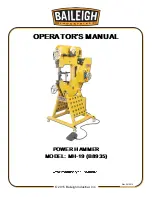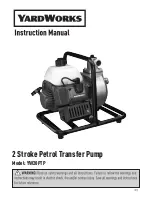
Page 5
For technical questions, please call 1-800-444-3353.
Item 68857
a.
maintain a firm grip with both hands on the
saw and position your arms to resist kickback
forces. position your body to either side
of the blade, but not in line with the blade.
Kickback could cause the saw to jump backwards,
but kickback forces can be controlled by the
operator, if proper precautions are taken.
b.
When blade is binding, or when interrupting
a cut for any reason, release the trigger
and hold the saw motionless in the material
until the blade comes to a complete stop.
never attempt to remove the saw from
the work or pull the saw backward while
the blade is in motion or kickback may
occur. Investigate and take corrective actions
to eliminate the cause of blade binding.
c.
When restarting a saw in the workpiece, center
the saw blade in the kerf and check that saw
teeth are not engaged into the material. If
saw blade is binding, it may walk up or kickback
from the workpiece as the saw is restarted.
d.
Support large panels to minimize the risk of
blade pinching and kickback. Large panels tend
to sag under their own weight. Supports must
be placed under the panel on both sides, near
the line of cut and near the edge of the panel.
e.
do not use dull or damaged blades.
Unsharpened or improperly set blades
produce narrow kerf causing excessive
friction, blade binding and kickback.
f.
Blade depth and bevel adjusting locking levers
must be tight and secure before making cut.
If blade adjustment shifts while cutting,
it may cause binding and kickback.
g.
use extra caution when making a
″plunge cut″ into existing walls or other
blind areas. The protruding blade may
cut objects that can cause kickback.
10.
check lower guard for proper closing before
each use. do not operate the saw if lower
guard does not move freely and close instantly.
never clamp or tie the lower guard into the
open position. If saw is accidentally dropped,
lower guard may be bent. Raise the lower guard
with the retracting handle and make sure it
moves freely and does not touch the blade or
any other part, in all angles and depths of cut.
11.
check the operation of the lower guard spring.
if the guard and the spring are not operating
properly, they must be serviced before use.
Lower guard may operate sluggishly due to damaged
parts, gummy deposits, or a build-up of debris.
12.
lower guard should be retracted manually
only for special cuts such as ″plunge
cuts″ and ″compound cuts.″ Raise lower
guard by retracting handle and as soon as
blade enters the material, the lower guard
must be released. For all other sawing, the
lower guard should operate automatically.
13.
always observe that the lower guard is covering
the blade before placing saw down on bench
or floor. An unprotected, coasting blade will cause
the saw to walk backwards, cutting whatever
is in its path. Be aware of the time it takes for
the blade to stop after switch is released.
14.
do not uSe thiS SaW With the SaW
held upSide doWn in a viSe. the
saw is not designed for such use and
cannot be used safely in that position.
15.
the torque developed during braking may
loosen the blade-retaining nut/bolt.
The blade
retaining nut/bolt should be checked periodically
and tightened if necessary, especially after braking.
16.
do not use to cut logs, tree
limbs, or uneven lumber.
17.
Wet lumber, green (unseasoned) lumber,
and pressure treated lumber all have an
increased potential for kickback and should
only be cut with a blade for cutting that
lumber type. Wear a nioSh-approved
respirator and have appropriate ventilation
whenever cutting pressure treated lumber.
18.
do not use blades made from high-speed steel,
abrasive blades, or metal- or masonry-cutting
blades.
The guards of this saw are not designed
to protect against the failure of such blades.
19.
place the larger portion of the saw base on
the larger, supported part of the workpiece.
This will help maintain balance and
control while the cut is completed.
20. Do not depress the spindle lock when
starting or during operation.
Reciprocating Saw Safety Warnings
1.
hold power tools by insulated gripping surfaces
when performing an operation where the cutting
tool may contact hidden wiring or its own cord.
Contact with a ″live″ wire will make exposed metal
parts of the tool ″live″ and shock the operator.
2.
use clamps or another practical way to secure
and support the workpiece to a stable platform.
Holding the work by hand or against your body
leaves it unstable and may lead to loss of control.
Sa
Fet
Y
o
pe
R
ation
m
aintenance
Setup





































